dashboard FIAT STILO 2006 1.G Owners Manual
[x] Cancel search | Manufacturer: FIAT, Model Year: 2006, Model line: STILO, Model: FIAT STILO 2006 1.GPages: 274, PDF Size: 4.76 MB
Page 115 of 274
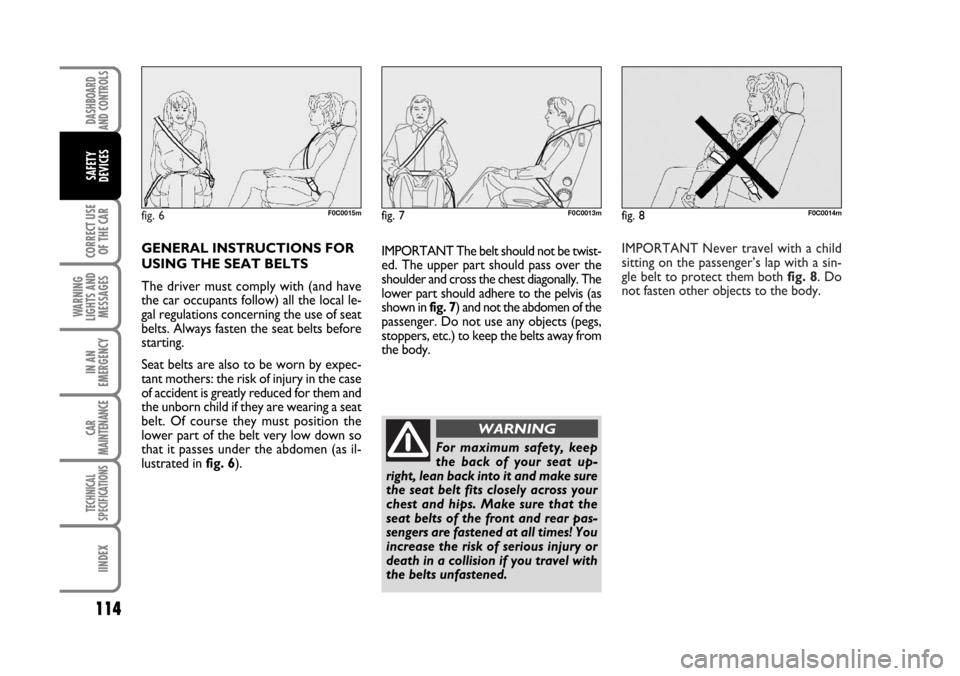
IMPORTANT Never travel with a child
sitting on the passenger’s lap with a sin-
gle belt to protect them both fig. 8. Do
not fasten other objects to the body.
fig. 6F0C0015mfig. 7F0C0013m
For maximum safety, keep
the back of your seat up-
right, lean back into it and make sure
the seat belt fits closely across your
chest and hips. Make sure that the
seat belts of the front and rear pas-
sengers are fastened at all times! You
increase the risk of serious injury or
death in a collision if you travel with
the belts unfastened.
WARNING
fig. 8F0C0014m
114
CORRECT USE
OF THE CAR
WARNING
LIGHTS AND
MESSAGES
IN AN
EMERGENCY
CAR
MAINTENANCE
TECHNICAL
SPECIFICATIONS
IINDEX
DASHBOARD
AND CONTROLS
SAFETY
DEVICES
GENERAL INSTRUCTIONS FOR
USING THE SEAT BELTS
The driver must comply with (and have
the car occupants follow) all the local le-
gal regulations concerning the use of seat
belts. Always fasten the seat belts before
starting.
Seat belts are also to be worn by expec-
tant mothers: the risk of injury in the case
of accident is greatly reduced for them and
the unborn child if they are wearing a seat
belt. Of course they must position the
lower part of the belt very low down so
that it passes under the abdomen (as il-
lustrated in fig. 6).IMPORTANT The belt should not be twist-
ed. The upper part should pass over the
shoulder and cross the chest diagonally. The
lower part should adhere to the pelvis (as
shown in fig. 7) and not the abdomen of the
passenger. Do not use any objects (pegs,
stoppers, etc.) to keep the belts away from
the body.
Page 116 of 274
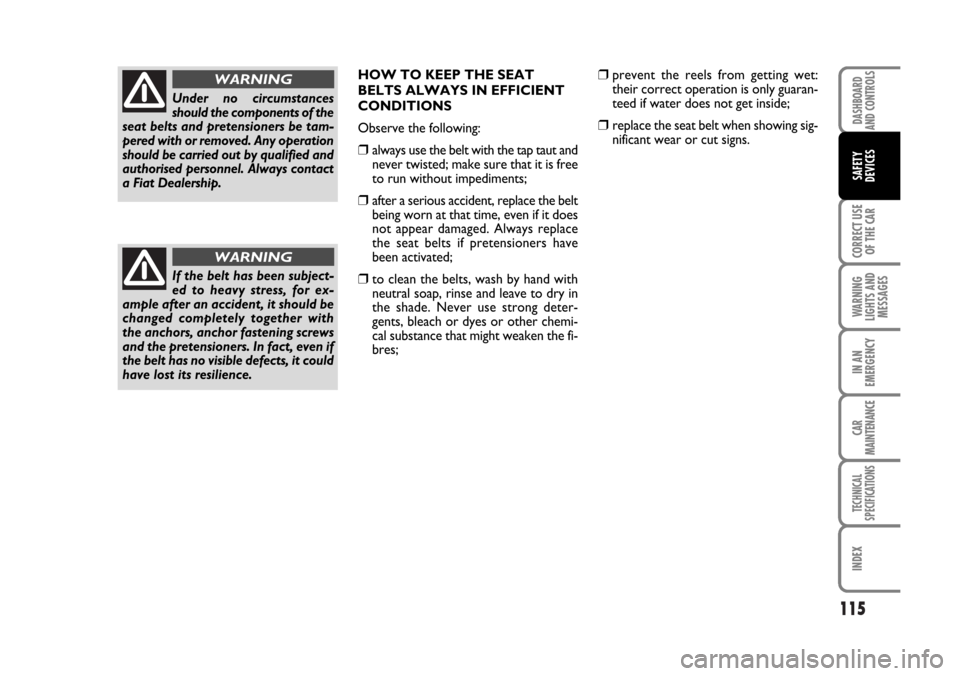
115
CORRECT USE
OF THE CAR
WARNING
LIGHTS AND
MESSAGES
IN AN
EMERGENCY
CAR
MAINTENANCE
TECHNICAL
SPECIFICATIONS
INDEX
DASHBOARD
AND CONTROLS
SAFETY
DEVICES
Under no circumstances
should the components of the
seat belts and pretensioners be tam-
pered with or removed. Any operation
should be carried out by qualified and
authorised personnel. Always contact
a Fiat Dealership.
WARNING
If the belt has been subject-
ed to heavy stress, for ex-
ample after an accident, it should be
changed completely together with
the anchors, anchor fastening screws
and the pretensioners. In fact, even if
the belt has no visible defects, it could
have lost its resilience.
WARNING
HOW TO KEEP THE SEAT
BELTS ALWAYS IN EFFICIENT
CONDITIONS
Observe the following:
❒always use the belt with the tap taut and
never twisted; make sure that it is free
to run without impediments;
❒after a serious accident, replace the belt
being worn at that time, even if it does
not appear damaged. Always replace
the seat belts if pretensioners have
been activated;
❒to clean the belts, wash by hand with
neutral soap, rinse and leave to dry in
the shade. Never use strong deter-
gents, bleach or dyes or other chemi-
cal substance that might weaken the fi-
bres;
❒prevent the reels from getting wet:
their correct operation is only guaran-
teed if water does not get inside;
❒replace the seat belt when showing sig-
nificant wear or cut signs.
Page 117 of 274
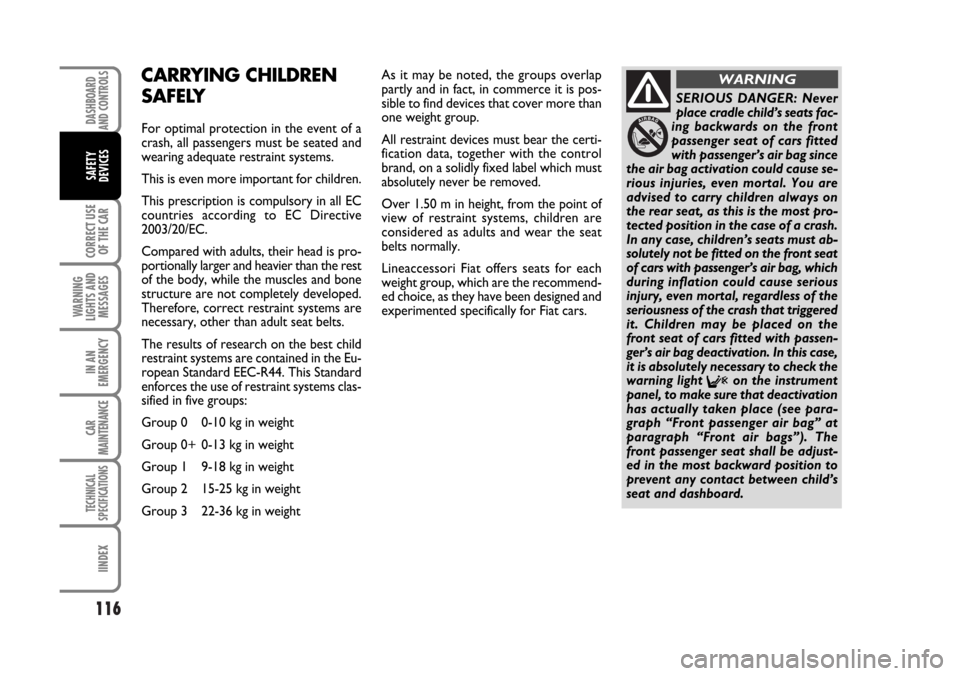
116
CORRECT USE
OF THE CAR
WARNING
LIGHTS AND
MESSAGES
IN AN
EMERGENCY
CAR
MAINTENANCE
TECHNICAL
SPECIFICATIONS
IINDEX
DASHBOARD
AND CONTROLS
SAFETY
DEVICES
SERIOUS DANGER: Never
place cradle child’s seats fac-
ing backwards on the front
passenger seat of cars fitted
with passenger’s air bag since
the air bag activation could cause se-
rious injuries, even mortal. You are
advised to carry children always on
the rear seat, as this is the most pro-
tected position in the case of a crash.
In any case, children’s seats must ab-
solutely not be fitted on the front seat
of cars with passenger’s air bag, which
during inflation could cause serious
injury, even mortal, regardless of the
seriousness of the crash that triggered
it. Children may be placed on the
front seat of cars fitted with passen-
ger’s air bag deactivation. In this case,
it is absolutely necessary to check the
warning light
Fon the instrument
panel, to make sure that deactivation
has actually taken place (see para-
graph “Front passenger air bag” at
paragraph “Front air bags”). The
front passenger seat shall be adjust-
ed in the most backward position to
prevent any contact between child’s
seat and dashboard.
WARNINGCARRYING CHILDREN
SAFELY
For optimal protection in the event of a
crash, all passengers must be seated and
wearing adequate restraint systems.
This is even more important for children.
This prescription is compulsory in all EC
countries according to EC Directive
2003/20/EC.
Compared with adults, their head is pro-
portionally larger and heavier than the rest
of the body, while the muscles and bone
structure are not completely developed.
Therefore, correct restraint systems are
necessary, other than adult seat belts.
The results of research on the best child
restraint systems are contained in the Eu-
ropean Standard EEC-R44. This Standard
enforces the use of restraint systems clas-
sified in five groups:
Group 0 0-10 kg in weight
Group 0+ 0-13 kg in weight
Group 1 9-18 kg in weight
Group 2 15-25 kg in weight
Group 3 22-36 kg in weightAs it may be noted, the groups overlap
partly and in fact, in commerce it is pos-
sible to find devices that cover more than
one weight group.
All restraint devices must bear the certi-
fication data, together with the control
brand, on a solidly fixed label which must
absolutely never be removed.
Over 1.50 m in height, from the point of
view of restraint systems, children are
considered as adults and wear the seat
belts normally.
Lineaccessori Fiat offers seats for each
weight group, which are the recommend-
ed choice, as they have been designed and
experimented specifically for Fiat cars.
Page 118 of 274
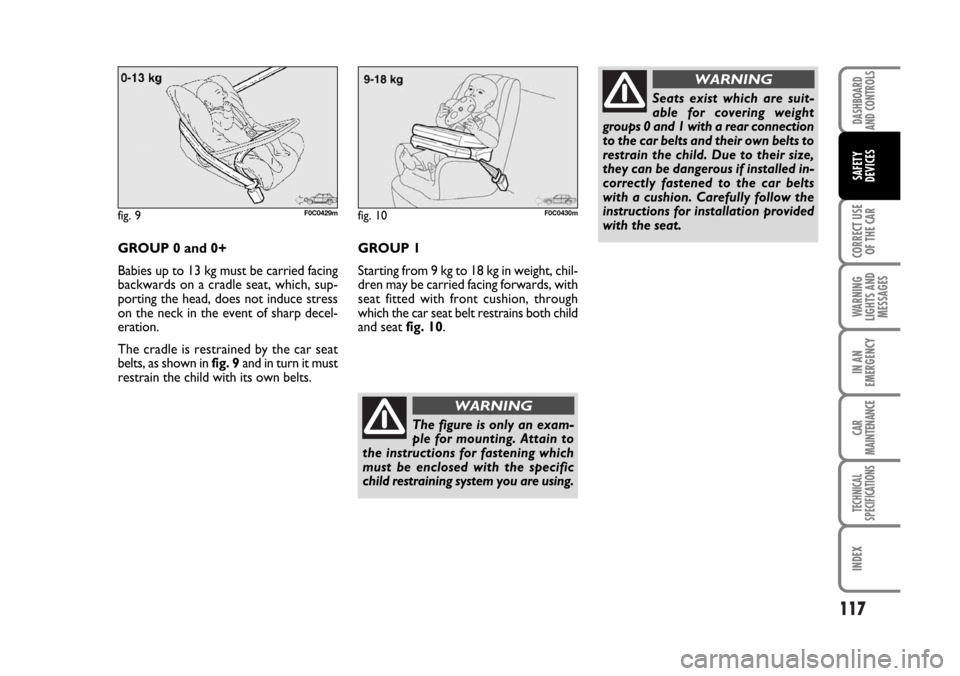
117
CORRECT USE
OF THE CAR
WARNING
LIGHTS AND
MESSAGES
IN AN
EMERGENCY
CAR
MAINTENANCE
TECHNICAL
SPECIFICATIONS
INDEX
DASHBOARD
AND CONTROLS
SAFETY
DEVICES
GROUP 0 and 0+
Babies up to 13 kg must be carried facing
backwards on a cradle seat, which, sup-
porting the head, does not induce stress
on the neck in the event of sharp decel-
eration.
The cradle is restrained by the car seat
belts, as shown in fig. 9and in turn it must
restrain the child with its own belts.
fig. 9F0C0429mfig. 10F0C0430m
The figure is only an exam-
ple for mounting. Attain to
the instructions for fastening which
must be enclosed with the specific
child restraining system you are using.
WARNING
Seats exist which are suit-
able for covering weight
groups 0 and 1 with a rear connection
to the car belts and their own belts to
restrain the child. Due to their size,
they can be dangerous if installed in-
correctly fastened to the car belts
with a cushion. Carefully follow the
instructions for installation provided
with the seat.
WARNING
GROUP 1
Starting from 9 kg to 18 kg in weight, chil-
dren may be carried facing forwards, with
seat fitted with front cushion, through
which the car seat belt restrains both child
and seat fig. 10.
Page 119 of 274
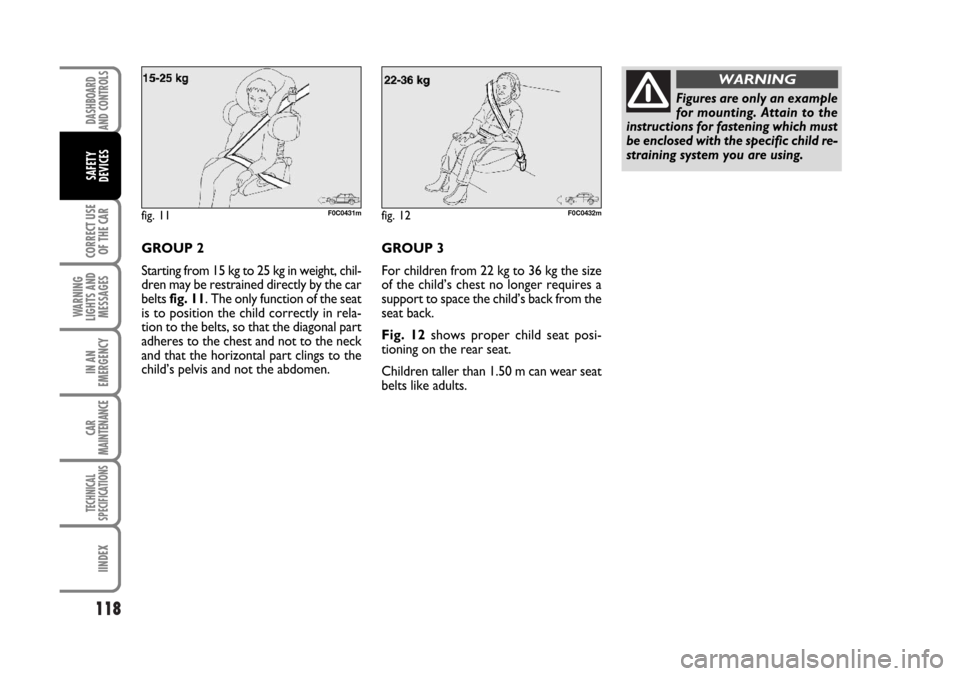
118
CORRECT USE
OF THE CAR
WARNING
LIGHTS AND
MESSAGES
IN AN
EMERGENCY
CAR
MAINTENANCE
TECHNICAL
SPECIFICATIONS
IINDEX
DASHBOARD
AND CONTROLS
SAFETY
DEVICES
GROUP 2
Starting from 15 kg to 25 kg in weight, chil-
dren may be restrained directly by the car
belts fig. 11. The only function of the seat
is to position the child correctly in rela-
tion to the belts, so that the diagonal part
adheres to the chest and not to the neck
and that the horizontal part clings to the
child’s pelvis and not the abdomen. GROUP 3
For children from 22 kg to 36 kg the size
of the child’s chest no longer requires a
support to space the child’s back from the
seat back.
Fig. 12shows proper child seat posi-
tioning on the rear seat.
Children taller than 1.50 m can wear seat
belts like adults.
fig. 11F0C0431mfig. 12F0C0432m
Figures are only an example
for mounting. Attain to the
instructions for fastening which must
be enclosed with the specific child re-
straining system you are using.
WARNING
Page 120 of 274
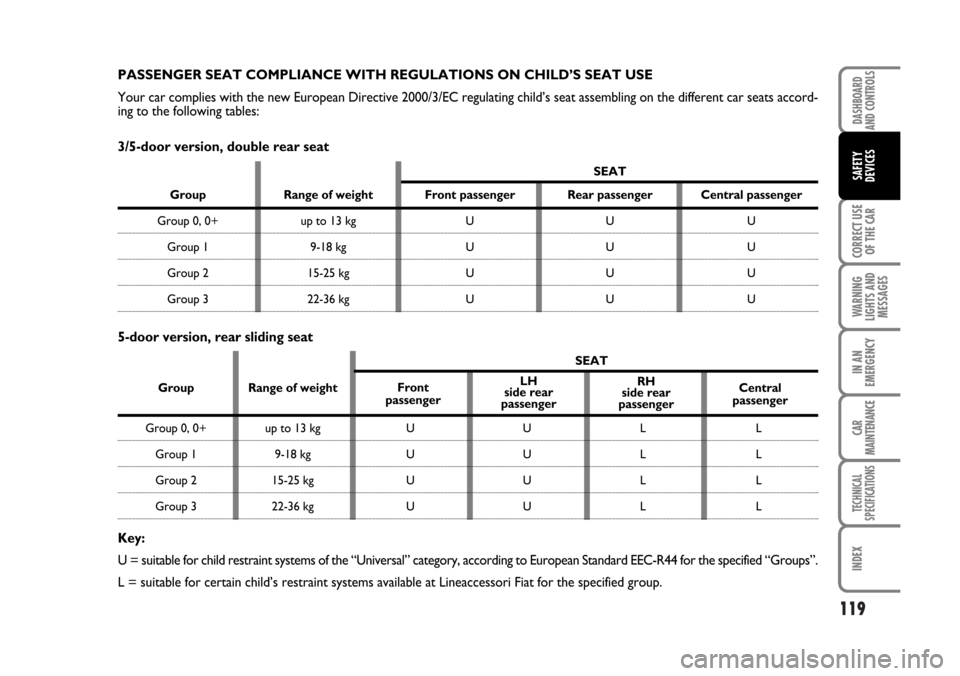
119
CORRECT USE
OF THE CAR
WARNING
LIGHTS AND
MESSAGES
IN AN
EMERGENCY
CAR
MAINTENANCE
TECHNICAL
SPECIFICATIONS
INDEX
DASHBOARD
AND CONTROLS
SAFETY
DEVICES
PASSENGER SEAT COMPLIANCE WITH REGULATIONS ON CHILD’S SEAT USE
Your car complies with the new European Directive 2000/3/EC regulating child’s seat assembling on the different car seats accord-
ing to the following tables:
3/5-door version, double rear seat
5-door version, rear sliding seat
SEAT
Group Range of weight Front passenger Rear passenger Central passenger
Group 0, 0+ up to 13 kg U U U
Group 1 9-18 kg U U U
Group 2 15-25 kg U U U
Group 3 22-36 kg U U U
Front
passengerCentral
passenger
Key:
U = suitable for child restraint systems of the “Universal” category, according to European Standard EEC-R44 for the specified “Groups”.
L = suitable for certain child’s restraint systems available at Lineaccessori Fiat for the specified group.
SEAT
Group Range of weight
Group 0, 0+ up to 13 kg U U L L
Group 1 9-18 kg U U L L
Group 2 15-25 kg U U L L
Group 3 22-36 kg U U L LRH
side rear
passenger LH
side rear
passenger
Page 121 of 274
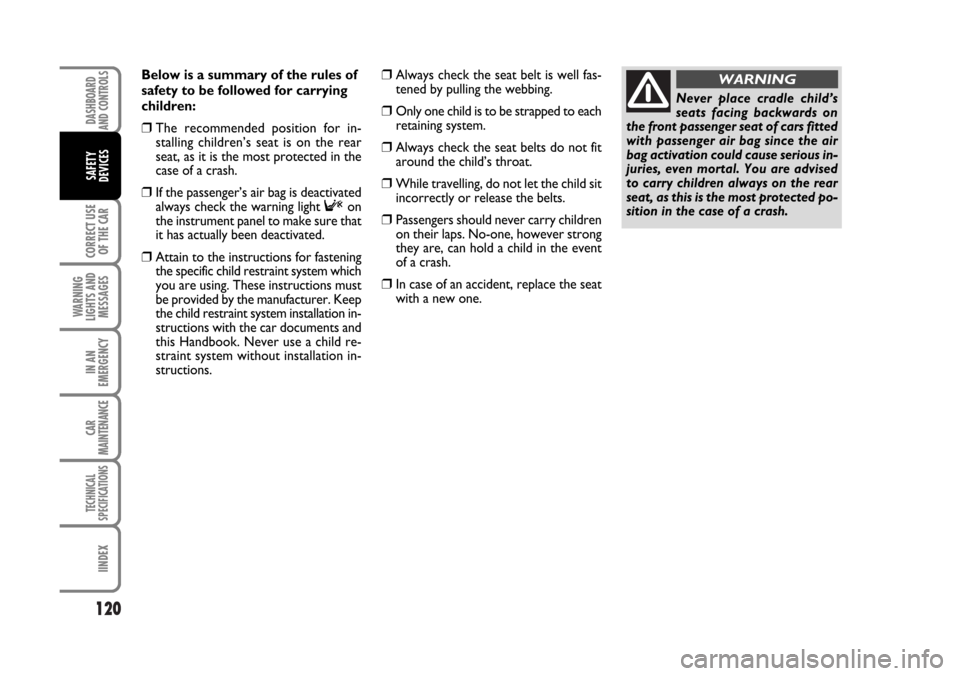
120
CORRECT USE
OF THE CAR
WARNING
LIGHTS AND
MESSAGES
IN AN
EMERGENCY
CAR
MAINTENANCE
TECHNICAL
SPECIFICATIONS
IINDEX
DASHBOARD
AND CONTROLS
SAFETY
DEVICES
Below is a summary of the rules of
safety to be followed for carrying
children:
❒The recommended position for in-
stalling children’s seat is on the rear
seat, as it is the most protected in the
case of a crash.
❒If the passenger’s air bag is deactivated
always check the warning light Fon
the instrument panel to make sure that
it has actually been deactivated.
❒Attain to the instructions for fastening
the specific child restraint system which
you are using. These instructions must
be provided by the manufacturer. Keep
the child restraint system installation in-
structions with the car documents and
this Handbook. Never use a child re-
straint system without installation in-
structions.
❒Always check the seat belt is well fas-
tened by pulling the webbing.
❒Only one child is to be strapped to each
retaining system.
❒Always check the seat belts do not fit
around the child’s throat.
❒While travelling, do not let the child sit
incorrectly or release the belts.
❒Passengers should never carry children
on their laps. No-one, however strong
they are, can hold a child in the event
of a crash.
❒In case of an accident, replace the seat
with a new one.
Never place cradle child’s
seats facing backwards on
the front passenger seat of cars fitted
with passenger air bag since the air
bag activation could cause serious in-
juries, even mortal. You are advised
to carry children always on the rear
seat, as this is the most protected po-
sition in the case of a crash.
WARNING
Page 122 of 274
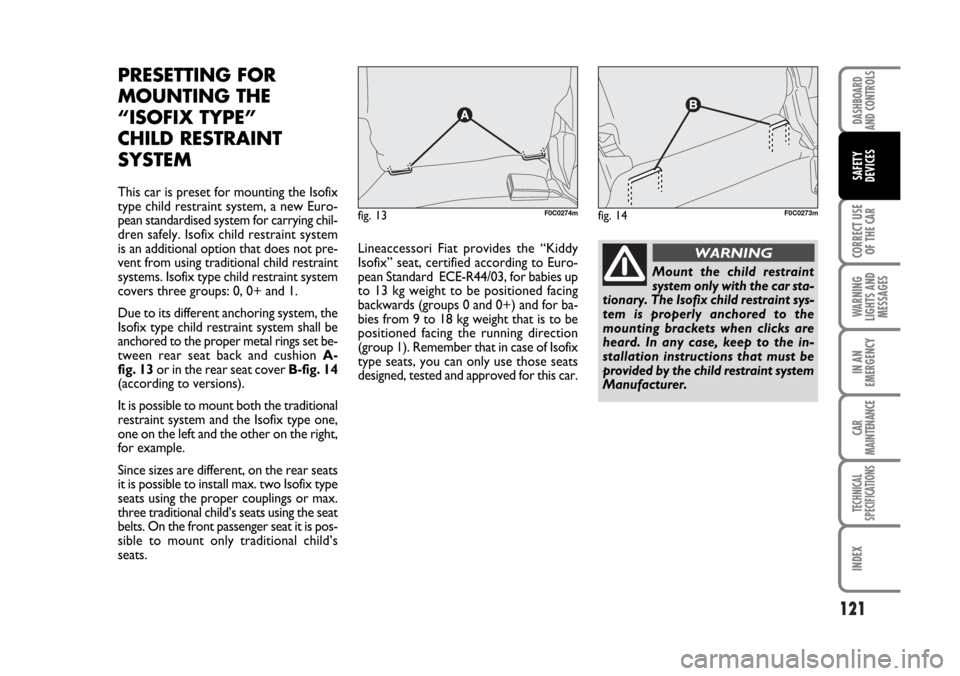
121
CORRECT USE
OF THE CAR
WARNING
LIGHTS AND
MESSAGES
IN AN
EMERGENCY
CAR
MAINTENANCE
TECHNICAL
SPECIFICATIONS
INDEX
DASHBOARD
AND CONTROLS
SAFETY
DEVICES
PRESETTING FOR
MOUNTING THE
“ISOFIX TYPE”
CHILD RESTRAINT
SYSTEM
This car is preset for mounting the Isofix
type child restraint system, a new Euro-
pean standardised system for carrying chil-
dren safely. Isofix child restraint system
is an additional option that does not pre-
vent from using traditional child restraint
systems. Isofix type child restraint system
covers three groups: 0, 0+ and 1.
Due to its different anchoring system, the
Isofix type child restraint system shall be
anchored to the proper metal rings set be-
tween rear seat back and cushion A-
fig. 13or in the rear seat cover B-fig. 14
(according to versions).
It is possible to mount both the traditional
restraint system and the Isofix type one,
one on the left and the other on the right,
for example.
Since sizes are different, on the rear seats
it is possible to install max. two Isofix type
seats using the proper couplings or max.
three traditional child’s seats using the seat
belts. On the front passenger seat it is pos-
sible to mount only traditional child’s
seats.Lineaccessori Fiat provides the “Kiddy
Isofix” seat, certified according to Euro-
pean Standard ECE-R44/03, for babies up
to 13 kg weight to be positioned facing
backwards (groups 0 and 0+) and for ba-
bies from 9 to 18 kg weight that is to be
positioned facing the running direction
(group 1). Remember that in case of Isofix
type seats, you can only use those seats
designed, tested and approved for this car.
fig. 13F0C0274mfig. 14F0C0273m
Mount the child restraint
system only with the car sta-
tionary. The Isofix child restraint sys-
tem is properly anchored to the
mounting brackets when clicks are
heard. In any case, keep to the in-
stallation instructions that must be
provided by the child restraint system
Manufacturer.
WARNING
Page 123 of 274
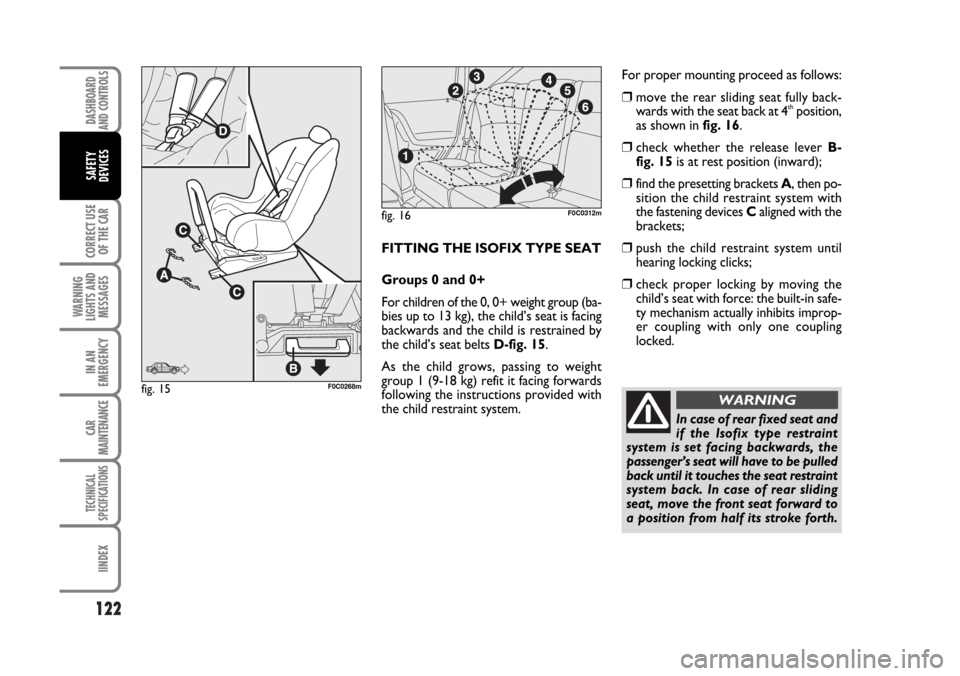
122
CORRECT USE
OF THE CAR
WARNING
LIGHTS AND
MESSAGES
IN AN
EMERGENCY
CAR
MAINTENANCE
TECHNICAL
SPECIFICATIONS
IINDEX
DASHBOARD
AND CONTROLS
SAFETY
DEVICES
FITTING THE ISOFIX TYPE SEAT
Groups 0 and 0+
For children of the 0, 0+ weight group (ba-
bies up to 13 kg), the child’s seat is facing
backwards and the child is restrained by
the child’s seat belts D-fig. 15.
As the child grows, passing to weight
group 1 (9-18 kg) refit it facing forwards
following the instructions provided with
the child restraint system.For proper mounting proceed as follows:
❒move the rear sliding seat fully back-
wards with the seat back at 4thposition,
as shown in fig. 16.
❒check whether the release lever B-
fig. 15is at rest position (inward);
❒find the presetting brackets A, then po-
sition the child restraint system with
the fastening devices Caligned with the
brackets;
❒push the child restraint system until
hearing locking clicks;
❒check proper locking by moving the
child’s seat with force: the built-in safe-
ty mechanism actually inhibits improp-
er coupling with only one coupling
locked.
fig. 16F0C0312m
fig. 15F0C0268m
In case of rear fixed seat and
if the Isofix type restraint
system is set facing backwards, the
passenger’s seat will have to be pulled
back until it touches the seat restraint
system back. In case of rear sliding
seat, move the front seat forward to
a position from half its stroke forth.
WARNING
Page 124 of 274

123
CORRECT USE
OF THE CAR
WARNING
LIGHTS AND
MESSAGES
IN AN
EMERGENCY
CAR
MAINTENANCE
TECHNICAL
SPECIFICATIONS
INDEX
DASHBOARD
AND CONTROLS
SAFETY
DEVICES
Group 1
For proper mounting proceed as follows:
❒move the rear sliding seat fully back-
wards with the seat back at 4thposition,
as shown in fig. 16;
❒check whether the release lever B-
fig. 17is at rest position (inward);
❒find the presetting brackets A, then po-
sition the child restraint system with
the fastening devices Caligned with the
brackets;
❒push the child restraint system until
hearing locking clicks;
❒for seats positioned facing the running
direction, hook the upper belt D-
fig. 18(in the upper seat pocket) to the
ring E in the boot;
❒Check proper locking by moving the
child’s seat with force: the built-in safe-
ty mechanism actually inhibits improp-
er coupling with only one coupling
locked.
With this configuration, the child is se-
cured also by the car seat belts and by the
upper belts. To apply car seat belts to
child’s seat refer to the child’s seat hand-
book.
fig. 17F0C0139m
fig. 18F0C0428m
In case of rear sliding seat,
move the front seat forward
to a position from half its stroke forth.
WARNING